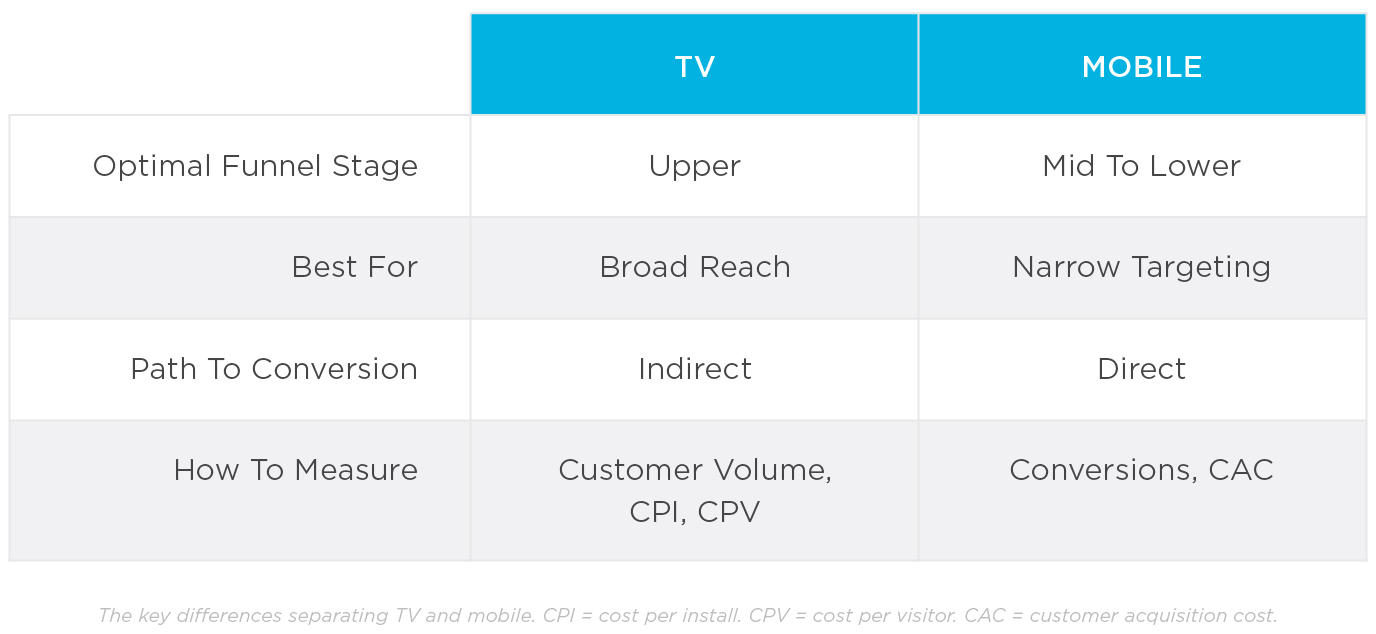By Matt Collins, SVP of Marketing, Simulmedia
At every one of my career stops, I’ve developed something of a love affair with the media channels at my immediate fingertips. Post-MBA (go Hoosiers!) I worked in video games, where I managed millions of dollars in TV media. Producing commercials was some of the most fun I’ve ever had—or ever will have—in marketing. Later, I worked on mobile apps at Nokia and Microsoft, and boy, did I cheerlead hard for mobile marketing.
I think the tendency to become exuberant, perhaps irrationally so, about the work that’s right in front of us is pretty common. The recent announcement that Kochava and Simulmedia made about giving Kochava customers access to TV viewing data has inspired me in a different way, having worked on both sides of mobile and TV, and therefore recognizing the potential this partnership offers marketers of both stripes. To reiterate the opportunity this partnership yields, I want to deliver the most valuable insights I’ve learned about top-of-funnel, TV advertising for those who work in performance at the funnel’s bottom, primarily through mobile.
Here, then, are the five most important things mobile marketers should know about linear TV, the stuff that comes through cable boxes or over-the-air and still reaches about 96% of all American households. 1
1. TV pitches. Mobile catches.
TV is, has been, and always will be the most effective medium for making it easier for customers to remember brands and buy them when the right moment arrives. It’s also a much more powerful ad medium than any other form of video. A recent study in the UK shows that in 2018, linear TV accounted for 95% of all video ad minutes consumed. 2 When done effectively, TV advertising eliminates much of the mental processing required to make a purchase decision and replaces it with a feeling, such as “I trust this brand” or “This brand gets me” or “I swear I see more hair on my head whenever I use this brand.”
Mobile engages closer to the moment of conversion. With one click or tap, consumers can jump from an ad to a product listing. In addition, mobile marketing flourishes when executed in conjunction with an initial stimulus delivered at scale. Before Dollar Shave Club launched its initial video campaign, who searched for “subscription men’s razors?” It took the sight, sound and motion of video – and linear TV in particular – to drive viewers to their search engines and social media feeds. (Perhaps you’re thinking, “This proves how powerful YouTube and viral videos can be!” Not so fast. This video has been watched over 26.5 million times on YouTube, but that’s just 4.5% of the 590 million impressions Dollar Shave Club got by advertising an edited version of this video on linear TV.)
So TV delivers people to your app at scale, giving your app—and the customer experience it enables—the opportunity to convert them into paying customers.
2. TV and mobile are different. Measure them differently.
Customers experience TV and mobile differently, on different devices, with different ad formats and in different contexts. That’s why they should not be held to the same standards. Here’s a summary of those differences and what it means regarding measurement for each channel.

TV can be measured very effectively on a CPI or CPV basis, but it can result in bad decisions when measuring on a CAC basis. For example, it often prevents advertisers from scaling beyond a small audience that converts cheaply, thus thwarting TV’s true power of driving targeted reach at scale. If you must hold every channel to the same CAC metric, then compare TV’s results to your brand’s prospecting work on Facebook.
3. TV can be optimized to improve CPI.
Though TV is best for targeted reach and scale, through advancements in technology, it’s now possible to plan, buy and measure TV in ways that resemble digital. As a result, TV can be optimized for improved performance over time.
Simulmedia has run campaigns for mobile app providers and reduced CPIs to levels that rival performance on Facebook. We’ve also seen TV campaigns make digital CPIs significantly less expensive when they run synchronously.
Here’s a summary of two campaigns we recently ran for a mobile e-commerce app that used TV to drive installs and in-app purchases. Reach more than doubled while the CPI was nearly cut in half as a result of optimizations we made for the second campaign.

4. The budget required to test TV is lower than you think.
This mobile e-commerce brand spent just $50,000 on its first TV campaign. Seeing positive results, they increased the budget to $80,000 for the second campaign. In other words, getting on TV, testing, and finding a path to scaling is attainable for many brands.
5. Don’t shortchange TV creatives.
Compared to mobile creatives, TV creatives are more immersive and engaging. Viewers typically watch TV on screens that dwarf the size of their phones or tablets. The video creative that works on mobile, often with or without volume and as short as just six seconds, usually doesn’t hold up when aired on a television.
With that in mind, invest in smart creatives. It does not have to cost a fortune, and the right provider will deliver variations that you can A/B test. Simulmedia knows creative shops that specialize in servicing advertisers that want to both build a brand and need to perform. We also offer resources to help advertisers who are new to TV navigate the creative process. Contact me (email address below) and I’ll hook you up.
If you’re eager to learn more about TV advertising and how you can use your Kochava customer data to find your mobile customers on TV, we’d love to help. Simply email me at mcollins@simulmedia.com to get started.
1. https://www.nielsen.com/us/en/insights/article/2018/nielsen-estimates-119-9-million-tv-homes-in-the-us-for-the-2018-19-season/
2. https://www.thinkbox.tv/news-and-opinion/blogs/tv-is-94-6-percent-of-video-advertising/
About Simulmedia
Simulmedia is a New York-based TV ad platform that enables predictable, scalable customer creation. Powered by the company’s patented software platform, robust data science and experienced media industry veterans, Simulmedia empowers marketers to rapidly receive audience and TV campaign insights, activate those insights via plans that quickly and cost efficiently reach more targeted customers on every Nielsen rated network at guaranteed scale, and optimize for continuous growth.

Matt Collins – SVP of Marketing
Simulmedia




